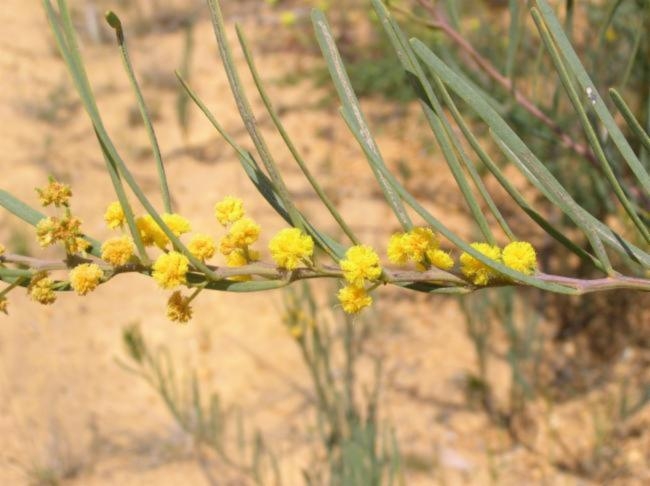Coastal Umbrella Bush
(Acacia cupularis)
Coastal Umbrella Bush (Acacia cupularis)
/
/

Ian McMaster
CC BY 4.0
Image By:
Ian McMaster
Recorded By:
Copyright:
CC BY 4.0
Copyright Notice:
Photo by: Ian McMaster | License Type: CC BY 4.0 | License URL: https://creativecommons.org/licenses/by/4.0/ | Publisher: Atlas of Living Australia |


























Estimated Native Range
Summary
Acacia cupularis, commonly known as Coastal Umbrella Bush, is a shrub endemic to the coastal dunes and limestone cliffs of southern Australia. It is a member of the genus Acacia within the subgenus Phyllodineae. This glabrous and open shrub typically grows to a height of 1.0 to 2.5 meters (3 to 8 ft) and to a width of around 2.5 m (8 ft 2 in). The Coastal Umbrella Bush is characterized by its bright yellow, spherical flower-heads that contain 16 to 22 individual golden flowers, blooming from July to December. The flowers are moderately showy and attract pollinators. Following the flowering period, the plant produces distinctive erect dark brown seed pods that resemble a string of beads, each pod measuring up to around 7 cm (2.8 in) in length and 4 to 5 mm (0.16 to 0.20 in) wide.
The Coastal Umbrella Bush is valued for its drought tolerance and ability to thrive in sandy soils, making it an excellent choice for coastal landscaping and erosion control. It is often used in xeriscaping, a landscaping method that reduces or eliminates the need for supplemental water from irrigation. In cultivation, it requires full sun exposure and can tolerate a range of soil drainage conditions, from slow to fast. While it is a low-maintenance plant, it is important to be aware of its potential invasiveness when grown outside its native range, particularly in regions such as North Africa, Southwest Asia, Australia, Chile, and the Mediterranean. Gardeners should consult local regulations before planting to prevent ecological disruptions.CC BY-SA 4.0
The Coastal Umbrella Bush is valued for its drought tolerance and ability to thrive in sandy soils, making it an excellent choice for coastal landscaping and erosion control. It is often used in xeriscaping, a landscaping method that reduces or eliminates the need for supplemental water from irrigation. In cultivation, it requires full sun exposure and can tolerate a range of soil drainage conditions, from slow to fast. While it is a low-maintenance plant, it is important to be aware of its potential invasiveness when grown outside its native range, particularly in regions such as North Africa, Southwest Asia, Australia, Chile, and the Mediterranean. Gardeners should consult local regulations before planting to prevent ecological disruptions.CC BY-SA 4.0
Plant Description
- Plant Type: Tree, Shrub
- Height: 3-8 feet
- Width: 6-8 feet
- Growth Rate: Rapid
- Flower Color: Yellow
- Flowering Season: Winter, Spring, Summer
- Leaf Retention: Evergreen
Growth Requirements
- Sun: Full Sun
- Water: Low
- Drainage: Slow, Medium, Fast
Common Uses
Bee Garden, Bird Garden, Butterfly Garden, Drought Tolerant, Hummingbird Garden, Low Maintenance
Natural Habitat
Coastal dunes and limestone cliffs of southern Australia
Other Names
Common Names: Orange Wattle
Scientific Names: , Acacia cupularis, Acacia salicina var. wayae, Acacia bivenosa subsp. wayi, Acacia salicina var. wayi, Acacia binervosa subsp. wayi, Acacia ligulata var. minor, Acacia salicina var. minor, Racosperma ligulatum var. minus,
GBIF Accepted Name: Acacia cupularis Domin